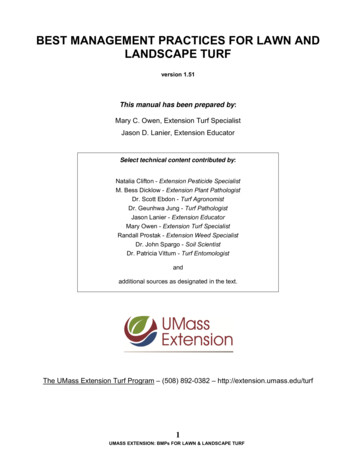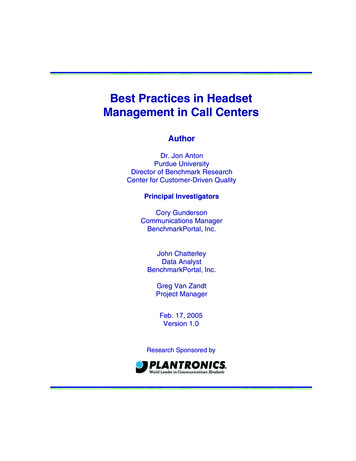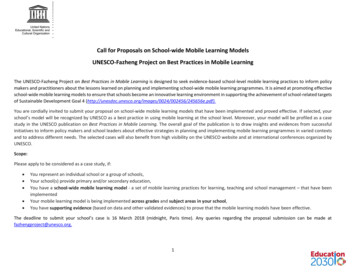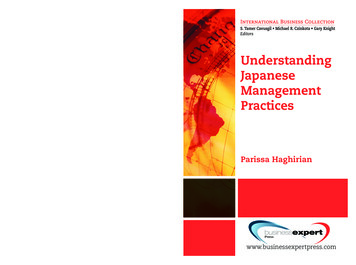
Transcription
BEST MANAGEMENT PRACTICES FOR LAWN ANDLANDSCAPE TURFversion 1.51This manual has been prepared by:Mary C. Owen, Extension Turf SpecialistJason D. Lanier, Extension EducatorSelect technical content contributed by:Natalia Clifton - Extension Pesticide SpecialistM. Bess Dicklow - Extension Plant PathologistDr. Scott Ebdon - Turf AgronomistDr. Geunhwa Jung - Turf PathologistJason Lanier - Extension EducatorMary Owen - Extension Turf SpecialistRandall Prostak - Extension Weed SpecialistDr. John Spargo - Soil ScientistDr. Patricia Vittum - Turf Entomologistandadditional sources as designated in the text.The UMass Extension Turf Program – (508) 892-0382 – http://extension.umass.edu/turf1UMASS EXTENSION: BMPs FOR LAWN & LANDSCAPE TURF
Project assistance graciously provided by:Steve Anagnos - Lawn Care Pros, Martha’s Vineyard, MATaryn LaScola - Massachusetts Department of AgriculturalResources, Boston, MADon McMahon - John Deere Landscapes, South Dennis, MACarl Quist - Town of Longmeadow, MATed Wales - Hartney Greymont, Needham, MAandLaurie Cadorette, UMass ExtensionThis project was originally part of a legislatively funded initiative undertaken by the University ofMassachusetts Extension Turf Program in cooperation with the Massachusetts Department ofAgricultural Resources and the Massachusetts Farm Bureau Federation. Copyright 2016 UMass Extension Turf Program. This document may not be reproduced in whole orin part for distribution without direct written permission from the UMass Extension Turf Program.The mission of the UMass Extension Turf Program is to develop, research, gather, and shareknowledge on safe, efficient, economically viable and environmentally sound turf management withemphasis on natural resource protection.The information in this guide is not presented as recommendations, but rather as research-based andexpertly audited knowledge intended to help practitioners make informed decisions. The contentauthors make no guarantees and assume no liability as to the efficacy of outlined practices or listedmaterials. The user of this information assumes all risks and liability for personal injury and propertydamage.2UMASS EXTENSION: BMPs FOR LAWN & LANDSCAPE TURF
TABLE OF CONTENTS(click blue titles to jump to desired section)INTRODUCTIONLAWN AND LANDSCAPE TURF: A KEY RESOURCE5BEST MANAGEMENT PRACTICES: AN OVERVIEW6USING THIS DOCUMENT7BEST MANAGEMENT PRACTICES1.DEVELOPMENT & MAINTENANCE OF A KNOWLEDGE BASE82.SITE ASSESSMENT103.DEVELOPMENT OF A MANAGEMENT PLAN134.TURFGRASS SELECTION185.ESTABLISHMENT, RENOVATION & REPAIR226.IRRIGATION AND WATER MANAGEMENT427.SOIL & NUTRIENT MANAGEMENT518.MOWING789.TRAFFIC STRESS & TURF CULTIVATION8210. WEED MANAGEMENT7811. INSECT MANAGEMENT9112. DISEASE MANAGEMENT9713. MANAGEMENT OF ABIOTIC PROBLEMS10214. PESTICIDE CONSIDERATIONS10515. SELECTION AND MANAGEMENT OF EQUIPMENT1153UMASS EXTENSION: BMPs FOR LAWN & LANDSCAPE TURF
APPENDICESA. Turf Pest Damage Monitoring Chart116B. Calendar for Cultural Practices and Related Activities121C. Elements of a Nutrient Management Plan for Turf123D. Contact Information for Lawn and Landscape Turf BMPProject Partners126E. Lawn and Landscape Turf Best Management PracticesReference List127F. Pesticide Regulatory Agencies in New England, New York,and New Jersey129G. Useful Information1314UMASS EXTENSION: BMPs FOR LAWN & LANDSCAPE TURF
INTRODUCTIONLAWN AND LANDSCAPE TURF: A KEY RESOURCEResidential and commercial lawns and utility-type turf comprise a significant portion of theMassachusetts landscape. These lawns may be at private residences, at businessestablishments, in industrial developments, on municipal properties, in parks, on public orprivate school grounds, and along roadsides and other utility areas. Lawns and similar turfareas are key resources, as they contribute to open space, provide recreation, add value toproperties, and help to protect the environment.Properly maintained turf provides many functional, recreational, and ornamental benefits,which are summarized below.Table 1. Benefits of turf.Functional Dust and mudcontrol Entrapment ofpollutants EnvironmentalprotectionRecreational Heat abatement Safe playingsurfaces Noiseabatement Low costsurfaces Mental health Physical health Security-visibilitySoil loss anderosion control Fire prevention Glare reduction Ground waterrecharge Greenhouse gasreductionSlopestabilization Storm waterabatement Protection ofundergroundutility servicesOrnamental Beauty Increasedpropertyvalue Communitypride Complementsthe landscape Mental healthEntertainmentAdapted from J. B. Beard and R. L. Green, 1994, from The Journal of Environmental Quality, The Roleof Turfgrasses in Environmental Protection and Their Benefits to Humans.Improperly or poorly maintained lawns are less functional in terms of aesthetics andrecreation, may result in inefficient use of valuable natural resources such as water, and aremore likely to be sources of environmental contamination.Best Management Practices (BMPs) are intended to maximize the benefits of lawn areasand to minimize the potential for environmental impact that can happen as a result ofinefficient, incorrect or irresponsible management practices.5UMASS EXTENSION: BMPs FOR LAWN & LANDSCAPE TURF
BEST MANAGEMENT PRACTICES: AN OVERVIEWBest Management Practices (BMPs) for lawn and landscape turf are economically feasiblemethods that conserve water and other natural resources, protect environmental quality andcontribute to sustainability.The BMPs detailed in this document are agronomically sound, environmentally sensiblestrategies and techniques designed with the following objectives: to protect the environmentto use resources in the most efficient manner possibleto protect human healthto enhance the positive benefits of turf in varied landscapes and usesto produce a functional turfto protect the value of propertiesto enhance the economic viability of Massachusetts businesses andcommunitiesThe BMPs in this document are based on the scientific principles and practices of integratedpest management (IPM). IPM is a systems approach that should form the foundation of anytype of sound turf management program. This holds true whether the materials being usedare organic, organic-based or synthetic. The components of IPM for lawn and landscape turfare detailed below and are described in more detail in later pertinent sections of thisdocument.What is IPM? - Integrated Pest Management (IPM) is a systematic approach toproblem solving and decision making in turf management. In practicing IPM, the turfmanager utilizes information about turf, pests, and environmental conditions incombination with proper cultural practices. Pest populations and possible impacts aremonitored in accordance with a pre-determined management plan. Should monitoringindicate that action is justified, appropriate pest control measures are taken to preventor control unacceptable turf damage. A sound IPM program has the potential to reducereliance on pesticides because applications are made only when all other options tomaintain the quality and integrity of the turf have been exhausted.The key components of an IPM system for turf can be tailored to fit most managementsituations. The steps in developing a complete IPM program are as follows:1.2.3.4.5.6.7.8.Assess site conditions and historyDetermine client or customer expectationsDetermine pest action levelsEstablish a monitoring (scouting) programIdentify the pest/problemImplement a management decisionKeep accurate records and evaluate programCommunicate6UMASS EXTENSION: BMPs FOR LAWN & LANDSCAPE TURF
These BMPs are intended for use in the management of lawn and landscape turf. Whilemany of the practices delineated can be applied to the management of sports turf and othermore intensively used turf, it is not the intent of this document to provide the more specializedBMPs that such intensive management systems require.These BMPs are designed to be used in a wide range of lawn and landscape managementsituations. Not every BMP will apply to every site. Activities and practices may varydepending on management objectives and site parameters. In addition, there may be aspecific practice or practices appropriate for an unusual site that does not appear in thisdocument.When instituting a management program based on BMPs, the turf manager must firstdetermine the desired functional quality of the lawn and the management level and resourcesnecessary to achieve it. Various factors will need to be considered including site parameters,level and intent of use, potential for pest infestation, pest action level, and environmentalsensitivity of the site.BMPs for maintenance of lawn and landscape turf areas are most effectively implemented byan educated and experienced turf manager, but can also serve as guidelines for lessexperienced turf managers and others caring for lawn and landscape turf.USING THIS DOCUMENTThe following describes the manner in which this document is set up: ال OBJECTIVEEach section of this document contains managementobjectives that lead to overall goals: safety,protection of water and other natural resources;enhancement of environmental quality, sustainability,and economic feasibility.Following each objective are the BMPs that support and contribute to that particularobjective. Additional supporting information and detail appears in the bulleted text below eachBMP.7UMASS EXTENSION: BMPs FOR LAWN & LANDSCAPE TURF
SECTION 1DEVELOPMENT AND MAINTENANCE OF A KNOWLEDGE BASE--- ال Maintain organized references on agronomics,management materials and pests, and provide foreasy access to information as needed.OBJECTIVEDevelop and maintain professional turf management competency. This may include attending degree or certificate programs, workshops, conferences,field days, seminars and/or webinars, and in-house and on-the-job trainingLearn about pest identification and biology to effectively implement pest managementstrategies. If an insect, disease, or weed population affects a lawn area, the turf manager must beknowledgeable about the life cycle of the problem pest.For example, when is damage most likely to occur? What is the most susceptiblestage for control? How can cultural practices be targeted to reduce pest populations?Maintain an organized library of turf management reference materials. The development of a library of reference materials will provide easy access toinformation as needed.Many excellent references are available. Consult Appendix E on page 127 of thisdocument for a list of suggested resources and references.Reference materials and other reliable information sources could include:-reference textbooks (see appendix)trade journalspest management guidesuniversity and associated newsletters and e-newsletterselectronic media, websites8UMASS EXTENSION: BMPs FOR LAWN & LANDSCAPE TURF
Create and maintain current files for key pests (weeds, diseases, and insects) as wellas abiotic stresses. Hard copy or electronic files may consist of articles, fact sheets, images, web sites,excerpts from larger publications, personal notes, etc.Example information that might be included in each pest file:-life cycleenvironmental conditions and weather that favor pest activitysymptomsbest monitoring timebest monitoring techniqueeffective management tools and techniques: cultural, chemical, biologicalObtain and maintain appropriate licenses and professional certifications. Individuals applying pesticides should be properly licensed and/or certified as requiredby law.Association memberships and professional certification programs (e.g. MCLP, MCH,CSFM) are useful avenues for professional development.Identify and access a reliable source of weather information regularly. Weather conditions and soil temperatures play a role in determining timing of culturalpractices as well as pest activity and severity.Types of critical data should include current, accurately predicted and archivedinformation on:-most recent and forecast weathertemperatureprecipitationrelative humidity and dew pointsNote and record specific weather or phenological information. It is often useful to monitor and record soil temperatures at 1.0 inch weekly during keytimes of the season at locations representative of the range of different microclimatesbeing managed.A record of dates of full bloom of key bio-indicator plants (i.e. Forsythia, dogwood,horsechestnut) can be important in tracking pest development.Major, extreme or unusual weather events and their effects on turf or implications forapplications of fertilizer or pest management materials.9UMASS EXTENSION: BMPs FOR LAWN & LANDSCAPE TURF
SECTION 2SITE ASSESSMENT--- ال Determine and record site conditions, including areasof environmental sensitivity, as well as current andpast problems and potential for future problems.OBJECTIVEConduct a detailed assessment of each site to be managed. Accurate site specifications are indispensible for planning with relation to managementpractices, materials applications, and renovation or reconstruction.Problem areas that impact turf health directly affect the potential loss of turf quality andfunction and increase the likelihood of pest infestations.Points to consider in a thorough site assessment include:-map or photo record of propertysquare footage of turf area(s) being manageddrainage patternsas-built drawings/maps of drainage and irrigation systemsdetermination of functional condition and adequacy of drainage andirrigation systemsthe age, condition, and species composition of the turf (includingcultivars if known)the physical condition, texture, and variation of soils on the sitea current soil pH and nutrient analysisthe fertility history and a summary of the current fertility programa pest history and current or potential problemsIdentify and record permanent features of each site in relation to management of theturf. Permanent features on or in close proximity to the site should be assessed from twoperspectives:1. How turf function and quality might be impacted by these features.2. How these features might be impacted by turf management practices.The following are important items and structures that might be included:-trees, shrubs, gardens and other landscape plantings.driveways and walkwaysparking lots and roadways10UMASS EXTENSION: BMPs FOR LAWN & LANDSCAPE TURF
fencingbuildingstemporary structuresmonuments or grave markersplaygrounds and/or daycare facilitiesdecorative pondssignificant abutters that have potential for impactChanges to this record should be made as they occur.Devote particular attention to the identification of areas of environmental sensitivity. Similar to above, areas of environmental sensitivity on or in close proximity to the siteshould be assessed from two perspectives:1. How turf function and quality might be impacted by these areas.2. How these areas might be impacted by turf management practices.The following are key areas that should be included:-wetland protection resource areaswells on propertywells in proximity to propertyZone I & II areassurface water featureshigh water table areascatch basinsexposed bedrockother environmentally sensitive areasDetermine and record agronomic problems in key locations and consider potentialsolutions. The recognition of agronomic problems is the first step in developing a solution.Problems to note include but are not limited to the following:-inappropriate turfgrass species or cultivarspoor fertilityundesirable soil typesexcessive thatchexcessive traffic stresscompactionpet damagepoor drainageshadelocalized dry spotspoor air circulation11UMASS EXTENSION: BMPs FOR LAWN & LANDSCAPE TURF
-southwest facing slopestree root influenceshallow soil or bedrockareas prone to damage from snow removal or salt application12UMASS EXTENSION: BMPs FOR LAWN & LANDSCAPE TURF
SECTION 3DEVELOPMENT OF A MANAGEMENT PLAN--- ال Determine the intended use and expected quality ofthe turf in making strategic and cultural managementdecisions.OBJECTIVEDetermine customer or client expectations to inform management objectives. In general, the higher the level of quality desired, and the more intense theuse of the turf, the higher the level of management needed to maintain a qualitysurface. Set realistic expectations based on communication between turf practitioner andcustomer or client.Expectations considerations include, but may not be limited to:-use and appearance of lawnacceptable level of pest infestationacceptable level of abiotic stressuse of water and other resourcesuse of synthetic, organic-based or organic management materialsbudget and other financial resourcesother site specific detailsHigh maintenanceModerate maintenance13UMASS EXTENSION: BMPs FOR LAWN & LANDSCAPE TURFMinimal maintenance
ال Determine and document action levels for variouspests.OBJECTIVEHow much pest activity can be tolerated before action is necessary? This question will help to determine the response threshold or action level.The action level is the point at which a pest population reaches a level capable ofcausing unacceptable damage to the turf.The higher the level of turf quality desired, the lower the action level and the morelikely it is that a turf manager will need to make a pesticide application to manage aproblem pest.Establish action levels for each key pest according to turf management objectives. Action levels for various pests will vary from site to site and may even vary fromarea to area on a given site.Due to the many factors that play a role in determining action levels, setting ‘acrossthe board’ levels is often not useful.Action levels may change during the growing season, in response to changes inmanagement inputs, or in response to other pest or abiotic problems.Action levels may be affected by the number of monitoring events or visits. In manycases, the less often monitoring is done, the more likely it is that the action levelwill be lower.Ancillary information such as plant phenology and bio-indicators (stage and date ofplant development) as well as growing degree days can also be considered.The following factors will influence action levels and should be considered carefully:- ال OBJECTIVEclient or customer expectationsmanagement objectivesturfgrass species and cultivars presentturf usevigor and condition of turftime of yearweather and environmental conditionsDevelop and implement a site specific managementplan.Set strategies for the upcoming year with an annual management plan. Formulate a yearly management plan based on site assessment information, clientexpectations and pest action levels as determined for the site.14UMASS EXTENSION: BMPs FOR LAWN & LANDSCAPE TURF
The following information at a minimum should be included:---management objectives and practicesregulations that impact the particular site, and compliance factors forthose regulationsidentification of agronomic problems, with a plan for addressing causes: irrigation drainage excess wear and traffic landscaping (trees and shrubs) soil problemscultural practices: construction, renovation, repair if needed seeding/overseeding irrigation fertility management mowing aeration and topdressing other practices specific to the sitescouting timetable and procedures identification of key pests in key locations at key times training and assignment of scouting personnelpest management strategies determination of pest action levels scouting/monitoring plan cultural management biological management pesticide managementMonitor or scout for pests, potential pest problems and environmental stresses. Managed sites should be checked on a routine basis for pest presence, pestpopulation density, and pest damage.Other potential problems (i.e. heat stress, excessive thatch accumulation, etc) shouldalso be noted and recorded.Consult the appropriate pest sections of this manual for information useful inmonitoring disease, insect, and weed pests as well as problems caused by abioticfactors.Refer to the Turf Pest Damage Monitoring Chart on page 116 for approximations ofwhen damage is most likely to occur.Keep a written record of monitoring findings with an intended course of action. List or map locations where particular or key pests or problems first occurred duringcritical periods.List or map locations where particular environmental or other abiotic stresses firstoccurred during critical periods.Record action needed, and also action taken.15UMASS EXTENSION: BMPs FOR LAWN & LANDSCAPE TURF
Record management activities. Keep a detailed record of yearly growing conditions and management activities.Suggested record items:- temperatureprecipitationhumiditypest problemspest ‘hot spots’pesticide applications and resultstiming, frequency and effectiveness of cultural practicesfertilizer and other materials applicationssoil and tissue test resultssoil pHuncommon occurrences such as flood, prolonged ice cover, etc.Note management activities that differ from those outlined in the yearly managementplan.Determine if measures taken to manage a pest or alleviate a problem were trulyeffective in protecting and maintaining the quality and viability of the turf. Theseevaluations should be maintained as a key aspect of the written record.Keep pesticide application records as required by law.If applicable, customer program, invoicing and associated records should be kept onfile.Staff are should be trained in Right to Know and other pertinent laws, anddocumentation should be retained in personnel files.Training records for staff using or handling materials and doing field work should beretained.Encourage and maintain communication between supervisors, crew and other staff. Effective communication will promote success of management decisions and results.Train staff and crew in proper procedures.Share the yearly management plan. Share management plans with appropriate staff, clients, and/or end-users. Discuss asneeded.Clients, and/or end-users who utilize turf subject to pesticide applications shouldreceive notification and documentation as required by law.If requested by clients and/or end-users, provide advance notice of site visits andapplications.Provide an information sheet, post-treatment instructions and documentation to clientsand/or end-users as appropriate.16UMASS EXTENSION: BMPs FOR LAWN & LANDSCAPE TURF
Evaluate the management plan as implemented. All aspects of the management plan including pest management strategies should beevaluated each year and a written summary kept.Management strategies that need to be adjusted or implemented during the comingyear can be identified in the course of the annual evaluation.17UMASS EXTENSION: BMPs FOR LAWN & LANDSCAPE TURF
SECTION 4TURFGRASS SELECTION--- ال OBJECTIVESelect turfgrass species and cultivars that are welladapted to the environmental conditions and to theintended use and maintenance level of a particularsite.Know the strengths and weaknesses of potential species and cultivars and select theright grasses for your site and management program. Turfgrass species vary in terms of appearance, appropriate uses, culturalrequirements, pest resistance and stress tolerance. Individual cultivars (or varieties)within species provide additional options for effectively matching grasses with growingconditions and desired performance.Selection of adapted turfgrass species and cultivars is fundamental to the success ofany management program for turf, as poorly adapted species and cultivars are majorcauses of turf deterioration.Adapted grasses require less input in terms of water, fertilizer, and pesticides, and arefar more likely to function as intended and exhibit favorable characteristics.Carefully consider the desired management level. Consider the intended level of cultural intensity, the type of use, and the desiredquality of the turf.Some grasses require a higher level of management input (water, fertility, mowing) toperform adequately than do some other grasses.High maintenance species are used where management receives a greater level ofattention and effort. Common high maintenance areas include golf courses, athleticfields, parks, and some commercial or residential lawns.If a lower-input management scheme is desired, grasses are available that perform atan acceptable level with a relatively lesser degree of maintenance.Low maintenance turf species are typically adapted to situations with reduced inputssuch as mowing, fertility, and irrigation. Areas appropriate for low maintenancespecies include roadsides, parking lots, industrial complexes, and some commercial orresidential lawns.When specifying mixed stands, consider how they will trend if inputs are higher orlower.18UMASS EXTENSION: BMPs FOR LAWN & LANDSCAPE TURF
Identify potential growth-limiting factors. Determine the characteristics and the adaptations of the turfgrass species (growthhabit, recuperative potential, leaf texture, shoot density, establishment rate,appropriate mowing height, etc).Abiotic growth limiting factors include conditions such as shade, traffic, infertility, acidicsoil pH, flooding, shallow root zone, poor soil, low temperature, drought, close mowing,etc.Biotic growth limiting factors include pests such as insects, diseases and weeds.Table 2. Traffic tolerance and ideal soil characteristics for selected ennialryegrassFine Fescues(Chewings,creeping red,hard)Tall fescueWearCompactionRecoverySoil TextureSoil pHFairGoodGoodWell drained6.0 to 7.0ExcellentExcellentPoorVariable6.0 to 7.0PoorPoorFairWell drained5.5 to 6.5ExcellentFairPoorVariable5.5 to 6.5Table 3. Environmental stress tolerances of selected cool-season ine fescues(Chewings,creeping red,hard)Tall PoorFairGoodExcellentGoodGood19UMASS EXTENSION: BMPs FOR LAWN & LANDSCAPE TURF
Table 4. Cultural and maintenance requirements of selected ennialRyegrassFine fescues(Chewings,creeping red,hard)Tall FescueShadePoorPoorHeight ofCut1.5 to 3.0inch1.5 to 3.0inchFertility hTendencyHighLowMediumExcellentLow1.5 to 3.0inchLowMediumFairMediumHigh1.5 to 3.0inchMediumLow* Fertility levels, in lbs. N per 1000 sq. ft.: medium-high 3 to 5; low 1 to 2.Take advantage of National Turfgrass Evaluation Program (NTEP) data. NTEP provides extensive, reliable information about the performance of turfgrassspecies and cultivars in specific regions of the country.NTEP does not make recommendations; therefore the data must be interpreted andused to make informed choices.The key parameter provided by NTEP is turfgrass quality (TQ). Other availabledescriptive data may include genetic color, density, leaf texture, winter injury, traffictolerance, disease potential, etc.NTEP information is free and can be accessed on the web at http://www.ntep.org.Mix or blend species and cultivars whenever possible. Use of a single turfgrass species for establishment of a stand is rarely appropriate forlawns and similar turf areas, and is more common on some athletic fields and manygolf courses.A turfgrass seed mix contains two or more different species of grasses.A turfgrass seed blend contains two or more cultivars of the same species of grass.Where appropriate, informed mixing and blending often results in a well-rounded turfthat performs better than the sum of its parts.To incorporate diverse tolerances to pest and environmental stresses, mixes and/orblends are nearly always preferred to ‘monostands’ (a planting consisting of the samespecies and/or cultivar).20UMASS EXTENSION: BMPs FOR LAWN & LANDSCAPE TURF
Table 5. Recommended turfgrass mixtures (and uses) for Massachusetts.Species (% by weight)Rate (lbs/1000 ft2)Lawns: sun,med. to highmaintenance65 to 75% Kentucky bluegrass*10 to 20% perennial ryegrass*15% fine fescue**3 to 4Lawns: sun,low maintenance65% fine fescue*10-20% perennial ryegrass*remainder Kentucky bluegrass4 to 6Lawns:shade80 to 90% fine fescue*10 to 20% perennial ryegrass*4 to 680% shade tolerant K. bluegrass*20% perennial ryegrass*3 to 4UseLawns:well drained*Two to three improved cultivars recommended.** One or more improved cultivars recommended.Exercise appropriate care when selecting and managing tall fescue. Tall fescue is more readily adaptable to certain areas of New England, particularly thesouthern coastal areas.Some tall fescue cultivars can become coarse and unthrifty under conditions in whichbetter adapted turfgrasses may grow.Careful cultivar selection is critical, not only for performance and quality, but also fordisease tolerance.Tall fescue is particularly susceptible to brown patch and Pythium diseases. ConsultUMass Extension’s 2010-2011 Professional Guide for IPM in Turf in Massachusetts, orNTEP data for disease tolerance of specific cultivars.Many tall fescue cultivars tend to become clumpy in heavily trafficked areas, and mayrequire frequent overseeding to maintain acceptable density.When it is desirable to use tall fescue in a lawn or in the landscape, use a mix of tallfescue in combination with Kentucky bluegrass or perennial ryegrass, with no lessthan 80% of the mix being tall fescue.21UMASS EXTENSION: BMPs FOR LAWN & LANDSCAPE TURF
SECTION 5ESTABLISHMENT, RENOVATION & REPAIR--Turf establishment, by the simplest definition, is the planting of turfgrasses. There areseveral different types of planting events, ranging from new plantings (i.e. constructing a newturf area where one did not exist before), to renovation or re-construction of an existing turfarea, to overseeding or repairs for established turf.Mature, well-established turf is most functional as well as most tolerant of pests, use, culturalpractices, and environmental stresses.
7 UMASS EXTENSION: BMPs FOR LAWN & LANDSCAPE TURF These BMPs are intended for use in the management of lawn and landscape turf. While many of the practices delineated can be applied to










